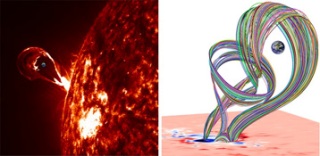Oct 25 2014
Researchers from the Centre de Physique Théorique (CNRS/École polytechnique) and the Laboratoire Astrophysique, Interprétation - Modélisation (CNRS/CEA/Université Paris Diderot) have identified a key phenomenon in the triggering of solar flares.
 Left: A typical solar flare. Right: Model of the magnetic rope during the flare. The Earth has been superimposed on both images to illustrate the huge scale of the phenomenon. © Tahar Amari / Centre de physique théorique
Left: A typical solar flare. Right: Model of the magnetic rope during the flare. The Earth has been superimposed on both images to illustrate the huge scale of the phenomenon. © Tahar Amari / Centre de physique théorique
Using satellite data and models, the scientists were able to monitor the evolution of the solar magnetic field in a region with eruptive behavior. Their calculations reveal the formation of a magnetic rope1 that emerges from the interior of the Sun and is associated with the appearance of a sunspot. They show that this structure plays an important role in triggering the flare. By characterizing the transition to the flare, their work opens the way to forecasting the solar storms that impact the Earth, and makes the cover story of Nature dated October 23.
Solar flares are events that occur in the Sun's atmosphere. They are characterized by emissions of light and particles and, in the case of large-scale flares, by the ejection of a plasma bubble2. Understanding the origin of such phenomena is of interest for a number of reasons. Firstly, solar flares are a local, easily observable example of physical phenomena that take place throughout the Universe. But it is mostly their impact on Earth's environment that makes them worth studying and forecasting. Indeed, solar flares cause multiple disturbances that affect ground-based electrical generators, satellites, GPS and communications systems, to name but a few.
The Sun's atmosphere is made up of a number of layers including the photosphere, which is the equivalent of the Sun's surface, and the corona, the outermost region where flares take place. There is a magnetic field in these layers, which plays an important role in solar flares. Until now, however, observations had not shed light on the mechanism and structures involved, especially because it is difficult to measure the magnetic field at every point in the extremely hot, tenuous corona.
A flare on the night of 12-13 December 2006 led to a significant breakthrough, as the region of the Sun where it occurred was being observed by the Japanese satellite Hinode - and had been during the days preceding it. Data about the magnetic field of the photosphere, which is colder and denser than the corona, were collected by the satellite and enabled the researchers to calculate the evolution of the magnetic environment in the corona during this period of time.
On the basis of calculations carried out at IDRIS (CNRS), the scientists showed that a characteristic structure, in the form of a magnetic rope, gradually appears in the days preceding the flare and is completely formed just before it occurs. This result is in very good agreement with observations carried out on the photosphere and the corona: the formation of the magnetic rope coincides with changes in sunspots in the region of the flare and with the emergence of other structures3. Their calculations also show that the energy of the magnetic rope increases as it emerges from the Sun's interior.
Thanks to a second series of numerical simulations the researchers then monitored the evolution of the magnetic field in the corona once the rope was present. Their results show that this structure really does cause the flare and is even necessary for it to occur: the transition to an eruptive event is not possible until it forms. This transition was characterized based on several criteria including an energy threshold and a given altitude beyond which the magnetic arcades that confine the rope become weaker. If these critical points are exceeded, there is a solar flare.
The researchers propose a method that could be useful for predicting flares.. On the basis of magnetic data collected in real time and a chain of suitable numerical models it will eventually prove possible, rather as in conventional meteorology, to forecast space weather and prevent the impact of solar storms on the Earth.